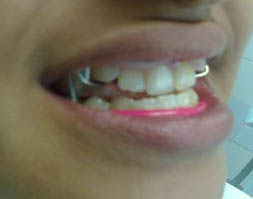Effectiveness of retro-stimulator 2 in the treatment of class III Moyers’ syndrome
Keywords:
MALOCCLUSION, ORTHODONTICS, ORTHODONTIC APPLIANCES, FUNCTIONAL, CEPHALOMETRY.Abstract
Introduction: class III malocclusions represent a challenge for clinical management; which are considered to be one of the most complex problems of orthodontics to be diagnosed and treated. Success in treatment depends on an adequate diagnosis, as well as timely intervention and the patient’s collaboration.
Objective: to determine the effectiveness of retro-stimulator wo in the treatment of Moyers class III syndrome in children between seven and 12 years old.
Method: a descriptive, longitudinal, prospective study was carried out at Ormani Arenado Clinic, Orthodontics Service. The target group consisted of 20 patients with class III syndrome; the sample corresponded to 10 patients who met the inclusion criteria. Clinical diagnosis and cephalometric study were performed before and after the orthodontic treatment, based on the functional retro-stimulating apparatus wo for the correction of this malocclusion. Descriptive statistics and non-parametric test of χ2with a significance level of 0.05 were used as summary measures.
Results: favorable changes in the profile and the nasolabial angle were obtained. There were no significant variations in the molar and canine relationship, predominating mesioclusion on both sides. The most notable cephalometric results were: increase of ANB angle by increase of SNA angle and decrease of SNB angle.
Conclusion: in the sample studied, the use of the retro-stimulator wo is an effective method for the treatment of Moyers class III syndromes.
Downloads
References
11. García Jiménez AM, Téllez Peña TM, Fontaine Machado O, Rodríguez Jiménez ML. Características de los pacientes con maloclusiones atendidos en la clínica dental docente "3 de octubre". Revista Electrónica Dr. Zoilo E. Marinello Vidaurreta [Internet]. 2016 [citado 2017 Abr 27]; 41(4): [Aprox. 12 p.]. Disponible en: http://revzoilomarinello.sld.cu/index.php/zmv/article/view/616
2. López Martín D, Cubero González R, Estrada Guerra Y, Estrada Guerra Y, Concepción López K, Machado Ramos S. Valor social de la prevención de factores de riesgo de maloclusiones en la dentición temporal. Mediciego. [Internet]. 2017 [citado 2017 mar 12]; 23(1): [Aprox. 14 p.]. Disponible en:http://www.revmediciego.sld.cu/index.php/mediciego/article/view/654/1083
3. De Armas Gallegos LI, Batista González NM, Fernández Pérez E. Alternativas de tratamiento ortopédico funcional para el síndrome Clase III en edades tempranas. Congreso Internacional de Estomatología 2015. [Internet]. 2015. [Citado 2016 feb 20]; [Aprox. 10 p]. Disponible en: http://estomatologia2015.sld.cu/index.php/estomatologia/nov2015/paper/view/235/116
4. Rezk Díaz A, Martínez Vergara Y, Martínez Rodríguez M, Bioti Torres AM. Maloclusión clase III tratada con retropropulsor- estimulador 2: un caso. Rev. Ciencias Médicas de Pinar del Río. [Internet]. 2016 Oct [citado 2017 Abr 27]; 20(5): [Aprox. 4 p.]. Disponible en: http://scielo.sld.cu/scielo.php?script=sci_arttext&pid=S1561-31942016000500017&lng=es
5. López YN. Función motora oral del lactante como estímulo de crecimiento craneofacial. Univ Odontol. [Internet]. 2016 Ene-Jun [citado 2017 Abr 27]; 35(74): [Aprox. 37 p.]. Disponible en: http://revistas.javeriana.edu.co/index.php/revUnivOdontologica/article/view/17763/13994
6. Avalos González GM, Paz Cristóbal AN. Maloclusión Clase III. Revisión Bibliográfica. Revista Tamé. [Internet]. 2014 [Citado 2016 feb 10]; 3(8): [Aprox. 4 p]. Disponible en: http://www.uan.edu.mx/d/a/publicaciones/revista_tame/numero_8/Tam148-7.pdf
7. Requena Martínez MA. Asociación entre los cambios producidos en los tejidos duros y blandos tras el tratamiento temprano con mentonera.[Tesis en Internet]. Madrid: Universidad de Granada. Facultad de Odontología; © 2015[citado 2017 abr 17]. [Aprox. 149 p.]. Disponible en: http://digibug.ugr.es/handle/10481/191
8. Alfonso Valdés H, Morejón Álvarez FC, García Díaz C, Corbo Rodríguez MT, Díaz Barrio H. El retropropulsor y estimulador de Buño: su uso en los prognatismos mandibulares, cambios cefalométricos. Rev. Ciencias Médicas [Internet]. 2014 Mayo-Junio, [citado 2015 mar]; 18(3): [Aprox. 14 p.]. Disponible en: http://www.revcmpinar.sld.cu/index.php/publicaciones/article/view/1364/pdf
9. Durán Vázquez WE, González Espangler L, Ramírez Quevedo Y. Uso del modelador elástico de Bimler en el tratamiento de pacientes con pseudomesioclusión. MEDISAN [Internet]. 2016 Jul [citado 2017 Abr 27]; 20(7): [Aprox. 16 p.]. Disponible en: http://scielo.sld.cu/scielo.php?script=sci_arttext&pid=S1029-30192016000700007&lng=es
10. Hernández Rodríguez JM, Machado Martínez M, Veliz Concepción OL, Riveras Truyt R, Ortega Romero L. Efecto del activador abierto elástico de Klammt III modificado en pacientes con fisuras labiopalatinas. Medicentro Electrónica. [Internet]. 2015 [citado marzo del 2015]; 19(3): [Aprox. 4 p.]. Disponible en: http://scielo.sld.cu/scielo.php?script=sci_arttext&pid=S1029-30432015000300003

Published
How to Cite
Issue
Section
License
Authors who have publications with this journal agree to the following terms: Authors will retain their copyrights and grant the journal the right of first publication of their work, which will be publication of their work, which will be simultaneously subject to the Creative Commons Attribution License (CC-BY-NC 4.0) that allows third parties to share the work as long as its author and first publication in this journal are indicated.
Authors may adopt other non-exclusive license agreements for distribution of the published version of the work (e.g.: deposit it in an institutional telematic archive or publish it in a volume). Likewise, and according to the recommendations of the Medical Sciences Editorial (ECIMED), authors must declare in each article their contribution according to the CRediT taxonomy (contributor roles). This taxonomy includes 14 roles, which can be used to represent the tasks typically performed by contributors in scientific academic production. It should be consulted in monograph) whenever initial publication in this journal is indicated. Authors are allowed and encouraged to disseminate their work through the Internet (e.g., in institutional telematic archives or on their web page) before and during the submission process, which may produce interesting exchanges and increase citations of the published work. (See The effect of open access). https://casrai.org/credit/


